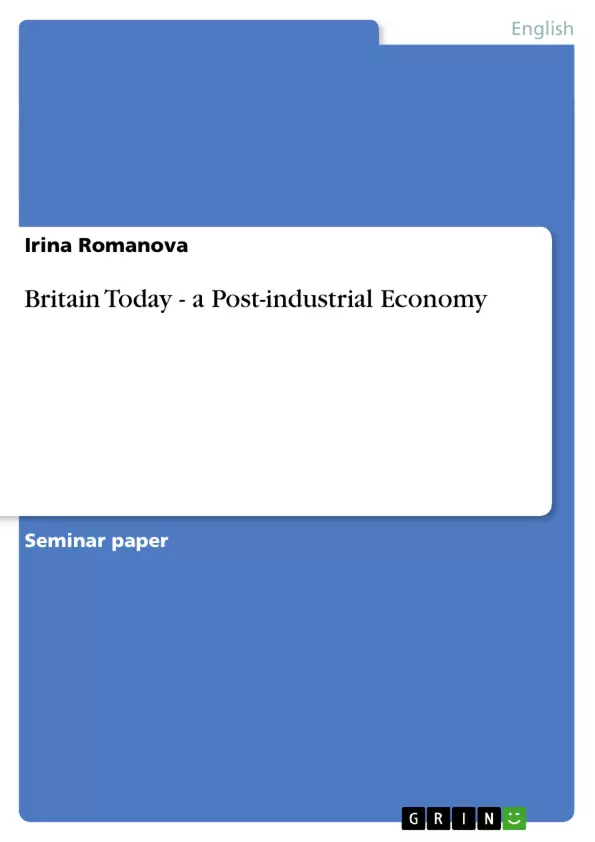Introduction
After the World War II Britain, although still a world power, was no longer a major one, and its position dwindled still further as it shed its Empire and attempted to negotiate entry into the EEC. Britain’s economic policies after the end of the World War II can be divided in to 3 main periods. The period 1945-1979 is characterised through Keynesian short-run demandmanagement policies. The British economist J. M. Keynes (1883-1946) advocated expanding the welfare state. In concrete terms this meant the development of a state- financed system of social security accessible to all citizens and state responsibility for the economy. According to this theory, the state should be more active in introducing regulations and controls aimed at influencing prices and wages, rather than just implementing economic policy in an attempt to prevent recession. Within Keynesianism, full or high employment was made a primary objective. State intervention in a “mixed” economy was also accepted.
Since 1979, the traditional Keynesian approach to macroeconomic policy had fallen from political favour. Monetarism was made an alternative to the post-war Keynesian orthodoxy. The Conservative government, which came to power under the leadership of Mrs Thatcher, was determined to make a complete break with the past in its management of the British economy. In contrast to Keynesian short-run demand policy, emphasis was placed on improving the long-run, supply-side performance of the economy. Like the economists of the 1920s and 1930s who were criticised by Keynes for putting too much faith in the market system, the new priorities (which actually were not new but just taken from the 1920s and 1930s) were for “sound money”, “balanced budgets”, “more competition”, and an overall reduction in public ownership and expenditure.1 Also, the abandonment of control over prices, incomes and capital movements, the return of stateowned industries to private ownership and management as well as the reduction in the power of trade unions combined with the reform of labour laws, were all seen to be necessary. This policy is known as Thatcherism. The term came into use in the early 1980s, pejoratively introduced by the journal Marxism Today, but given favourable connotations by N. Lawson, a high-powered financial journalist and later the Chancellor of the Exchequer in the second Thatcher administration.
Inhaltsverzeichnis (Table of Contents)
- Introduction
- British economy under M. Thatcher 1979-1990
- From Keynesian demand management to Thatcherism
- Thatcherism in operation: 1979-1983
- Britain's economic miracle 1983-1990
- Britain's economic development under Conservative rule 1990-1997
- Economic recession of the early 1990s
- Economic policy and performance of the British economy during the last years of Tory governing
- Economic policy under Labour 1997-2004
- New Labour: the “third way”
- Economic policy and performance of the Blair government
- Current state and structure of the British economy
- Britain and the euro
- Conclusion
Zielsetzung und Themenschwerpunkte (Objectives and Key Themes)
This seminar examines the economic development of Great Britain from the post-World War II period to the early 2000s, focusing on the evolution of economic policy and its impact on the nation's economic performance. The work analyzes the shift from Keynesian demand management to Thatcherism, explores the economic policies of the Conservative and Labour governments, and examines the current state of the British economy.
- The transition from Keynesian economics to Thatcherism and its implications for British economic policy.
- The impact of economic policies under Conservative rule, including the period of recession in the early 1990s.
- The implementation of the "third way" economic policy under the Labour government, and its effects on the British economy.
- The current state of the British economy, including its structure and position within the global market.
- The potential impact of Britain's relationship with the euro on its economic future.
Zusammenfassung der Kapitel (Chapter Summaries)
The introduction provides a general overview of Britain's economic history since the World War II, highlighting the shift from Keynesian demand management policies to the dominance of Thatcherism. This section emphasizes the role of the state in influencing economic activity.
The first chapter delves into the period of Thatcherism, contrasting it with the earlier Keynesian approach. This chapter explores the key elements of Thatcherism, including its emphasis on market freedom, financial discipline, and supply-side economics.
The second chapter examines Britain's economic development under the Conservative rule, analyzing the recession of the early 1990s and the subsequent economic policies implemented. It also explores the impact of these policies on the British economy.
The third chapter focuses on the Labour government and its implementation of the "third way" economic policy. This section analyzes the policies of the Blair government, assesses their impact on the British economy, and examines the current state of the economy.
Schlüsselwörter (Keywords)
The key themes and concepts explored in this seminar include Keynesian economics, Thatcherism, supply-side economics, demand management, economic recession, the "third way", globalization, the European Union, and the euro.
- Quote paper
- Irina Romanova (Author), 2004, Britain Today - a Post-industrial Economy, Munich, GRIN Verlag, https://www.grin.com/document/36308



